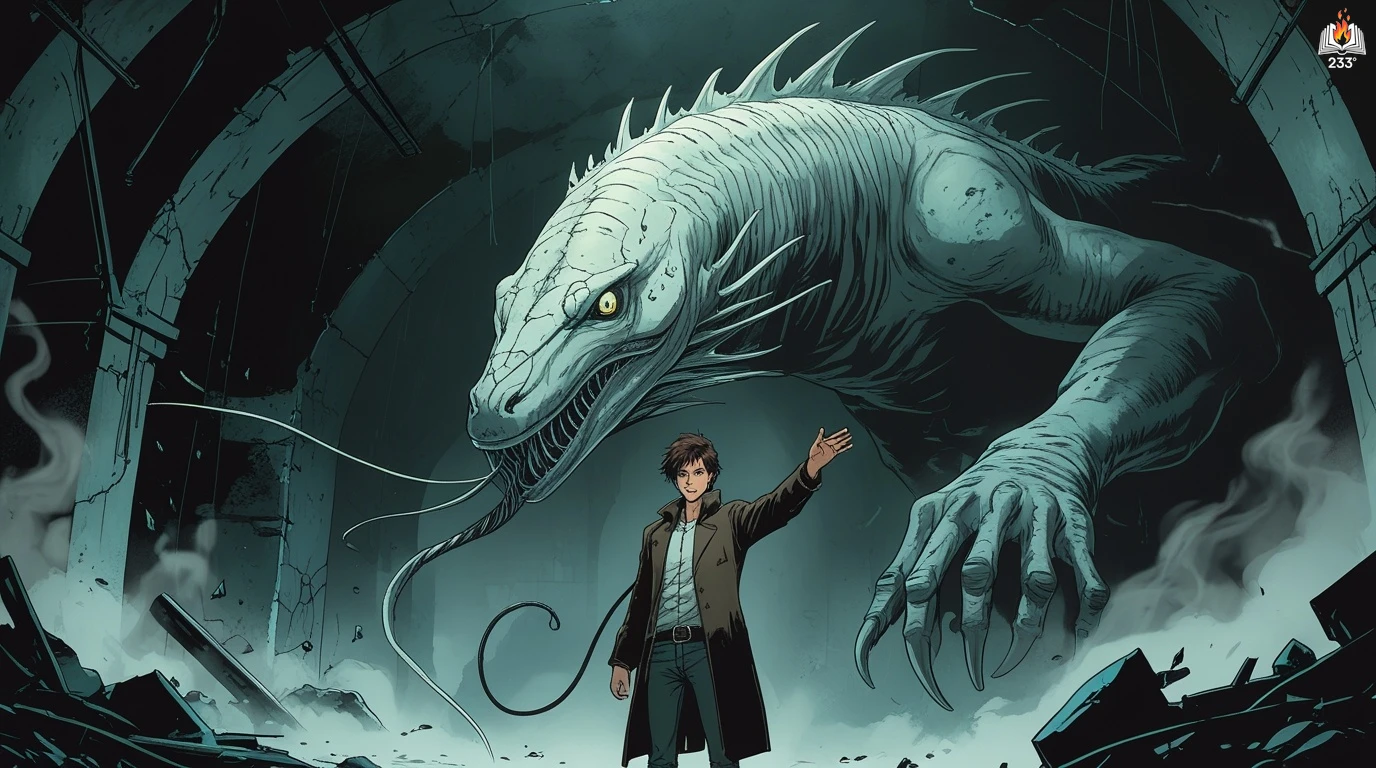Miss Peregrine’s Home for Peculiar Children by Ransom Riggs, published in 2011, is the first book in a bestselling fantasy series that blends haunting vintage photographs with a mysterious, atmospheric tale of self-discovery, grief, and adventure. Centered on a teenager’s journey to uncover his grandfather’s past, the novel draws readers into a hidden world of “peculiars” – children with extraordinary abilities – and the dark forces that pursue them.
Plot Summary
Jacob Portman’s life in suburban Florida seemed ordinary, shaped by the hum of his family’s drugstore empire and the fading magic of childhood. But within him pulsed the echoes of tales told by his grandfather, Abraham Portman – a boyhood of monsters and peculiar children on a faraway island. Abe’s stories had once fired Jacob’s imagination, but by adolescence, they had become an embarrassment, reduced to the fading quirks of an old man. Until the night the old man died.
The call came while Jacob worked a shift he loathed, the kind of job expected of a boy with family ties. Abe’s frantic voice trembled over the line, rambling about keys and monsters. Jacob brushed it off as another fit of confusion. But when he arrived at Abe’s house, something was terribly wrong. Rooms lay in chaos, shadows stretched long across the yard, and in the woods, Jacob found his grandfather torn and bleeding under the trees, the life ebbing from him in ragged breaths. With his final words, Abe spoke of an island, a bird, a loop, and a date from decades past: September third, 1940.
The terror of that night refused to loosen its grip. Jacob’s dreams were filled with creatures of glistening tongues and hollow eyes. His parents, desperate to mend what was unraveling in their son, sent him to Dr. Golan, a calm, steady presence who promised healing but offered little more than pills and polite concern. But healing did not come. Jacob’s nights remained haunted, his days filled with the ache of questions. What had Abe meant? And what truth lurked behind the veil of his fantastic tales?
Fate slipped a letter into Jacob’s hands – a brittle, yellowing envelope tucked inside the pages of a book Abe had left for him. The letter came from Miss Alma Peregrine, headmistress of a home on Cairnholm Island, Wales. The photograph enclosed showed a stern-faced woman with a pipe, her name a quiet whisper of destiny. Jacob clung to this fragile clue, his one thread in the labyrinth of grief and confusion. Persuading his parents was no small feat, but with Dr. Golan’s support and his father’s sudden enthusiasm for the island’s birdlife, Jacob boarded a plane bound for the wild edges of the world.
Cairnholm greeted them with gray skies, salt-stung winds, and the restless cries of gulls. The island was a place of fishers and stone houses, its residents wary of strangers, its mysteries locked away in time. With his father distracted by seabirds and half-written manuscripts, Jacob slipped away to find the ruins of Miss Peregrine’s Home for Peculiar Children, a house blown apart by a Luftwaffe raid decades ago. Yet among the crumbling walls and rotting beams, Jacob felt something stir, a tug just beyond the veil of ordinary sight.
It was in the hush of twilight that the peculiar children appeared. Emma, with fire blooming at her fingertips; Millard, the invisible boy; Bronwyn, the gentle giantess; and Enoch, brooding and sharp-edged, with the power to rouse the dead. They belonged to another time, another world – one preserved in a time loop by Miss Peregrine herself, where September third, 1940, repeated endlessly to shield them from the war and the hunger of monstrous predators.
Miss Peregrine, part woman, part falcon, kept the loop intact, guarding her wards against the hollowgasts – creatures born from a failed alchemical experiment, once human, now twisted into something otherworldly. Lurking behind them were the wights, hollowgasts’ human-like masters, with their cold cunning and thirst for domination. As Jacob learned of the peculiar world, he discovered his own inheritance: the ability to see the monsters when others could not, a rare and vital gift.
But danger had followed Jacob across the sea. Dr. Golan, the gentle voice from his therapy sessions, was no mere psychiatrist. He was a wight, his eyes fixed on the peculiar children and the key to unraveling the loops that kept their kind safe. His arrival shattered the uneasy peace of Cairnholm. With Miss Peregrine captured and transformed into her bird form, unable to shift back, the children’s sanctuary crumbled. The loop’s collapse meant exposure, and exposure meant death.
Jacob stood at the threshold of two worlds, torn between the life he knew and the one now calling him. His bond with Emma deepened, a thread of love tangled with sorrow. Together, they led the others in a desperate chase across the island, through mist and ruin, over jagged cliffs and churning seas, to save their headmistress and preserve the fragile world they had built.
As they clashed with the wights, Jacob’s courage blossomed from the shy, hesitant boy he had been into something fierce and resolute. His gift became the shield behind which the peculiar children rallied, their strange powers no longer curiosities but weapons of survival. Yet, victory came at a cost. With Miss Peregrine trapped in her avian form and the loop in ruins, the children had no choice but to leave the island and step into the vast unknown.
As dawn broke over the sea, Jacob gazed back one last time at the island where his grandfather’s ghosts had led him. The boy who had arrived in search of answers now set sail with a new family, a new purpose, and a heart both heavy with loss and burning with hope. The world stretched wide and wild before them, and the road ahead promised both peril and wonder.
Main Characters
Jacob Portman: Jacob, the teenage protagonist, begins as a disenchanted and grieving grandson struggling to reconcile his grandfather’s wild tales with reality. His arc transforms from skepticism and anxiety to bravery and leadership as he uncovers the truth about his grandfather’s past and his own peculiar inheritance. Jacob’s search for belonging and identity drives the emotional core of the narrative.
Abe Portman: Jacob’s grandfather, a Polish Jewish war refugee, captivates Jacob in childhood with stories of monsters and peculiar children. While first dismissed as a teller of tall tales, Abe’s mysterious past and sudden violent death catalyze the entire plot. His legacy haunts and shapes Jacob’s journey.
Emma Bloom: A fiercely independent and courageous girl from Miss Peregrine’s home, Emma has the ability to create fire with her hands. She was once close to Abe and becomes an emotional anchor for Jacob, pushing him to embrace his role among the peculiars and to confront looming dangers.
Miss Peregrine: The strict yet protective headmistress of the home, Miss Peregrine can transform into a peregrine falcon and has the power to manipulate time. She serves as a guardian figure for the peculiar children, creating a “loop” to shield them from the outside world and the monstrous wights.
Millard Nullings: An invisible boy with a sharp mind, Millard provides historical and factual insights. His invisibility serves as both a strength and a symbol of the loneliness many peculiar children feel.
Enoch O’Connor: A brooding, morbid boy who can animate the dead or inanimate with hearts of other creatures. Enoch’s cynicism and dark wit offer both tension and dark humor within the group.
Dr. Golan: Initially appearing as Jacob’s psychiatrist, Dr. Golan is later revealed to be a sinister figure tied to the wights. His deception and betrayal amplify the tension and threat looming over the peculiar children.
Theme
Identity and Belonging: At its heart, the novel explores Jacob’s search for his own identity and a place where he feels he belongs. This theme resonates across the peculiar children, who, despite their powers, crave acceptance and family.
The Nature of Time and Memory: The time loop in which the peculiar children live represents both safety and stagnation. Riggs uses this motif to reflect on the desire to preserve innocence and youth, while confronting the dangers of living in the past.
Grief and Loss: Jacob’s journey is shaped by his grandfather’s death and the unraveling of their relationship’s truths. The novel meditates on how we carry those we’ve lost, blending memory, myth, and longing.
Monsters as Metaphor: The hollowgasts and wights are literal monsters, but they also symbolize human evil, prejudice, and the shadows of history (especially tied to WWII and the Holocaust). Abe’s “monsters” as a child were both fantasy creatures and the Nazis he fled.
The Power of Storytelling and Photography: The novel’s integration of eerie vintage photos reinforces the idea that stories, memories, and images shape our understanding of the world. Jacob must navigate which stories are real, exaggerated, or suppressed.
Writing Style and Tone
Ransom Riggs writes in an atmospheric, cinematic style, blending lush, sensory details with spare, clipped dialogue that creates tension and intimacy. His language balances wonder with menace, evoking the eerie beauty of forgotten places, decaying homes, and magical oddities. Riggs crafts his prose with an eye for the gothic, imbuing ordinary objects and settings with a sense of unease, much like the old photographs that anchor the book.
The tone oscillates between melancholic and adventurous, layered with nostalgia, humor, and suspense. Riggs captures the ache of grief and alienation while infusing the narrative with moments of sharp wit and excitement. His use of first-person narration deepens the reader’s immersion into Jacob’s psyche, allowing us to experience his fear, awe, and transformation firsthand. The blend of vintage photos with text amplifies the uncanny atmosphere, giving the book a tactile, almost documentary-like strangeness.
We hope this summary has sparked your interest and would appreciate you following Celsius 233 on social media:
There’s a treasure trove of other fascinating book summaries waiting for you. Check out our collection of stories that inspire, thrill, and provoke thought, just like this one by checking out the Book Shelf or the Library
Remember, while our summaries capture the essence, they can never replace the full experience of reading the book. If this summary intrigued you, consider diving into the complete story – buy the book and immerse yourself in the author’s original work.
If you want to request a book summary, click here.
When Saurabh is not working/watching football/reading books/traveling, you can reach him via Twitter/X, LinkedIn, or Threads
Restart reading!








